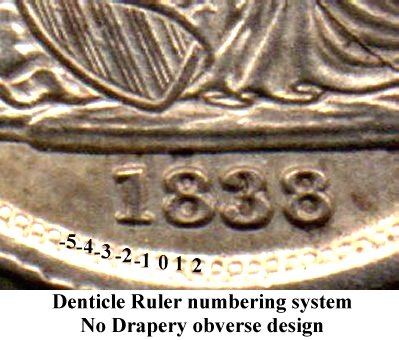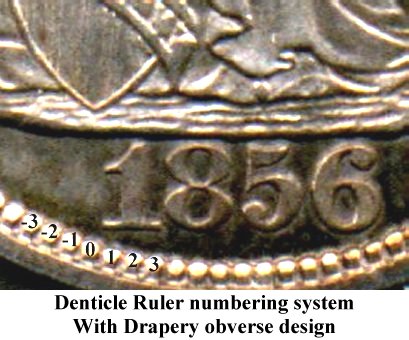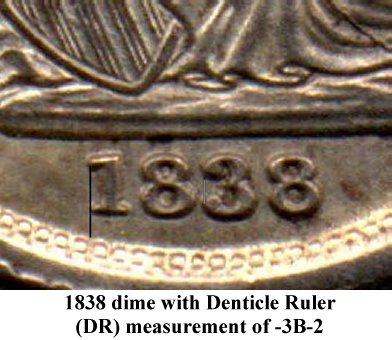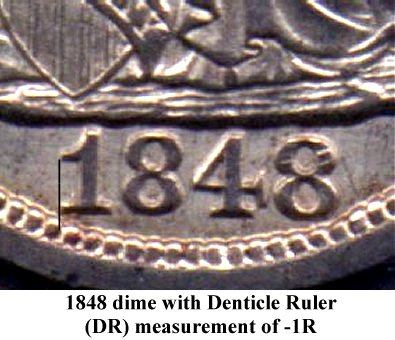

|
|
|
Methods For Obverse Die Attribution
Two primary methods are utilized for obverse die identification. They are Shield Position (SP) published by Kam Ahwash in the Encyclopedia of United States - Liberty Seated Dimes and secondly, the Denticle Ruler (DR) published by the author in The Gobrecht Journal Collective Vo,ume Number 4. Each identification method has successfully been utilized by Seated Dime variety collectors to differentiate obverse dies.
Denticle Ruler (DR)
The Denticle Ruler again uses Liberty's shield as a reference point. A vertical line is sighted from the lower point of the shield to a denticle directly below the lower shield point. This denticle acts as the point of reference for date position measurements and is assigned a numbered 0 position. The denticle to the immediate right of the #0 denticle is numbered 1. The next denticle to the right of the #1 denticle is numbered 2 and so on. The denticle to the immediate left of the #0 denticle is numbered -1. The next denticle to the left of the #-1 denticle is numbered -2 and so on. These numbered denticles act as a measurement ruler for determining date placement. For increasing measurement resolution, each denticle is subdivided into three equal parts labeled left (L), center (C) and right (R). An example of a typical subset of denticle ruler measurement points for a numbered 0 denticle, from left to right, would be 0L, 0C, 0R. The final step to complete the denticle ruler is defining points between any two denticles. The point directly between two numbered denticles is designated as a point between (B) a left and right numbered denticle. The point between numbered 0 and 1denticles is designated 0B1. A denticle ruler measurement subset from the numbered -1 denticle through numbered 1 denticle would be named as:
-1L, -1C, -1R, -1B0, 0L, 0C, 0R, 0B1, 1L, 1C, 1R
The following images present visual examples of the denticle ruler measurement system for No Drapery and Drapery obverse hub designs.


To determine the denticle ruler position of a date, the placement of the outer end of the left foot of the 1 in the date is compared to the denticle directly below it. A measurement of the date position is then taken from the denticle ruler numbering system illustrated above. Examples of denticle ruler measurements are presented for No Drapery and Drapery obverses in the following images.


The concept of the denticle ruler measurement system was initially suggested by Brian Greer to the author in or around the year 1992. Its development and usage by the author has been necessary for the quantification of small variations in horizontal date placements for all die hub designs. The author highly recommends that users of this book become immediately familiar with the denticle ruler system.